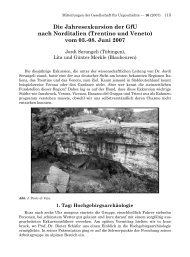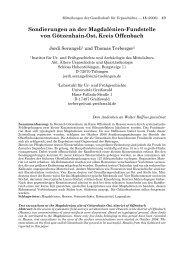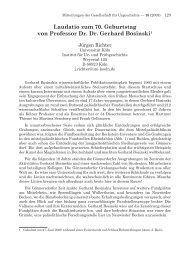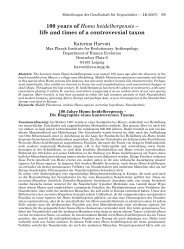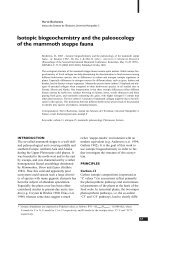bronze age environment and economy in the troad - Universität ...
bronze age environment and economy in the troad - Universität ...
bronze age environment and economy in the troad - Universität ...
Create successful ePaper yourself
Turn your PDF publications into a flip-book with our unique Google optimized e-Paper software.
chapter 1: <strong>environment</strong> <strong>and</strong> archaeology<br />
beg<strong>in</strong>n<strong>in</strong>g of roughly 2900 BP) <strong>in</strong> sou<strong>the</strong>rn Turkey, where decreased<br />
summer temperatures or a high presence of clouds<br />
were <strong>in</strong>terpreted from a decrease <strong>in</strong> Compositae pollen, that<br />
were recognised to have <strong>in</strong>creased <strong>in</strong> <strong>the</strong> previous phase by hot<br />
upw<strong>in</strong>ds through strong <strong>in</strong>solation <strong>and</strong> heat<strong>in</strong>g of <strong>the</strong> earth<br />
(Bottema, Woldr<strong>in</strong>g <strong>and</strong> Aytug 1986).<br />
O<strong>the</strong>r problems arise with <strong>the</strong> synchronisation of <strong>the</strong> eastern<br />
vegetation successions with <strong>the</strong> Middle European basic succession,<br />
particularly with regard to <strong>the</strong> postglacial woodl<strong>and</strong> development<br />
on <strong>the</strong> Mediterranean coast (Beug 1967).<br />
The apparent <strong>in</strong>consistency is a strongly deviat<strong>in</strong>g vegetation<br />
development <strong>in</strong> different regions. Consider<strong>in</strong>g additionally <strong>the</strong><br />
low cover<strong>age</strong> of pollen cores, <strong>the</strong>se variations are not that astonish<strong>in</strong>g.<br />
For example van Zeist <strong>and</strong> Bottema (1982) could<br />
demonstrate that differences <strong>in</strong> vegetation development existed<br />
between nor<strong>the</strong>rn Israel <strong>and</strong> northwestern Syria <strong>in</strong> <strong>the</strong> Postglacial<br />
period (11/10000-6000 BP), but also <strong>in</strong> earlier periods,<br />
such as <strong>the</strong> Pleniglacial. Variations are sometimes expla<strong>in</strong>ed by<br />
differences <strong>in</strong> w<strong>in</strong>d circulation systems, an aspect which was<br />
discussed by B<strong>in</strong>tliff (1982) as a more progressive approach to<br />
past climates.<br />
After <strong>the</strong> Pleniglacial period humidity seems to have <strong>in</strong>creased<br />
cont<strong>in</strong>uously, with regional differences, such as a later <strong>in</strong>crease<br />
of humidity <strong>in</strong> sou<strong>the</strong>astern Turkey, deducted from a later distribution<br />
of woodl<strong>and</strong> (i.e. <strong>in</strong>crease of wood pollen). Generally<br />
an <strong>in</strong>crease of humidity took place between c. 10500 <strong>and</strong> 6000<br />
(5000) BP, when modern climatic conditions were reached.<br />
The palynological evidence from Near Eastern sites (exclud<strong>in</strong>g<br />
western Anatolia) suggests that at least from 6000 BP onward<br />
no considerable change <strong>in</strong> vegetation or climate occurred<br />
(Bottema <strong>and</strong> van Zeist 1981). A problem of lack of direct<br />
evidence becomes obvious <strong>in</strong> <strong>the</strong> palaeo-vegetation map by<br />
van Zeist <strong>and</strong> Bottema (1982). The map is based on <strong>the</strong> palynological<br />
results from Greece, but shows cont<strong>in</strong>uous forest<br />
cover for <strong>the</strong> western Anatolian coast from around 8000 BP.<br />
There are also difficulties <strong>in</strong> <strong>in</strong>terpret<strong>in</strong>g climatic <strong>in</strong>dicators <strong>in</strong><br />
<strong>the</strong> eastern Mediterranean for <strong>the</strong> period between 3500 <strong>and</strong><br />
1000/750 BC (Subboreal period), which might have been<br />
caused by a regime of variable wea<strong>the</strong>r. B<strong>in</strong>tliff (1982) observes<br />
that “<strong>the</strong> implications for <strong>the</strong> Mediterranean latitude<br />
(with <strong>the</strong> development <strong>in</strong> north-west Europe) are not clear-cut.<br />
One might expect after <strong>the</strong> Piora fluctuation (cool phase <strong>in</strong> <strong>the</strong><br />
nor<strong>the</strong>rn hemisphere dur<strong>in</strong>g <strong>the</strong> Atlantic period, 5000-3500 bc)<br />
onwards <strong>in</strong> time, a marked variability at different longitudes of<br />
<strong>the</strong> Mediterranean with unusually dry zones adjacent to unusually<br />
wet zones... ” (p. 510).<br />
With<strong>in</strong> <strong>the</strong> Subboreal period, <strong>the</strong> end of <strong>the</strong> Late Bronze Age<br />
has been <strong>the</strong> object of vigorous discussion, <strong>in</strong> <strong>the</strong> search for<br />
reasons for <strong>the</strong> collapse of Mycenaean civilisation.<br />
The architectural evidence for <strong>the</strong> collapse is visible <strong>in</strong> destruction,<br />
but also <strong>in</strong> constructions. There are <strong>in</strong>tentionally fire-destroyed<br />
build<strong>in</strong>gs <strong>in</strong> Mycenae <strong>and</strong> o<strong>the</strong>r archaeological sites<br />
(Gla) <strong>in</strong> LH IIIB, but also re<strong>in</strong>forcement of fortifications <strong>and</strong><br />
<strong>the</strong> construction of underground water supply systems at<br />
Mycenae <strong>and</strong> o<strong>the</strong>r archaeological sites (Tiryns), for defensive<br />
purposes. Numerous sites were ab<strong>and</strong>oned or destroyed ei<strong>the</strong>r<br />
with<strong>in</strong> or at <strong>the</strong> very end of LH IIIB (before 1200 BC). Some<br />
are believed to have been destroyed by natural disasters, such<br />
as earthquakes (Tiryns). Depopulation of <strong>the</strong> centres <strong>in</strong> <strong>the</strong><br />
subsequent LH IIIC phase is archaeologically recognisable.<br />
Besides <strong>the</strong> ma<strong>in</strong> ideas on <strong>the</strong> reasons for Mycenaean collapse,<br />
such as <strong>the</strong> neo-marxist <strong>the</strong>ory of <strong>in</strong>ternal social revolution,<br />
disruption of commerce by <strong>the</strong> Sea Peoples, <strong>in</strong>vasion over l<strong>and</strong><br />
from <strong>the</strong> North, or <strong>the</strong> more unpopular idea of <strong>in</strong>vaders on a<br />
lower cultural level than <strong>the</strong> <strong>in</strong>habitants, <strong>the</strong>re is also <strong>the</strong> argument<br />
of climatic change as a reason for <strong>the</strong> collapse.<br />
Carpenter (1966) suggests <strong>in</strong> his hypo<strong>the</strong>sis a mosaic of<br />
drought <strong>and</strong> normal ra<strong>in</strong>fall over <strong>the</strong> eastern Mediterranean<br />
region around 1200 BC (around <strong>the</strong> end of <strong>the</strong> LH IIIB), as a<br />
consequence of <strong>the</strong> distribution of relief <strong>and</strong> atmospheric circulation<br />
(B<strong>in</strong>tliff 1982). Accord<strong>in</strong>g to Carpenter, <strong>the</strong> drought, as<br />
<strong>the</strong> ma<strong>in</strong> factor for <strong>the</strong> disruption of agriculture, affected areas<br />
of Crete, <strong>the</strong> sou<strong>the</strong>rn Peloponnese <strong>and</strong> <strong>the</strong> Argolid but did not<br />
particularly affect <strong>the</strong> northwest Peloponnese, Thessaly <strong>and</strong> <strong>the</strong><br />
rest of nor<strong>the</strong>rn Greece. His hypo<strong>the</strong>sis that <strong>the</strong> Late Bronze<br />
Age collapse was l<strong>in</strong>ked to climatic change was supported later<br />
by palaeoclimatological <strong>in</strong>vestigations by Lamb (1967),<br />
Bryson et al. (1974), Weiss (1982), <strong>and</strong> more cautiously by<br />
Kuniholm (1990). They confirmed that a pattern of drought<br />
such as that postulated by Carpenter is <strong>in</strong> fact possible, while<br />
Neumann (1993) takes <strong>the</strong> view that <strong>the</strong> opposite, i.e. cool <strong>and</strong><br />
humid w<strong>in</strong>ters, was <strong>the</strong> case. The chronology of <strong>the</strong> respective<br />
events is ano<strong>the</strong>r problem, because of a lack of dates.<br />
Some archaeologists have doubts about <strong>the</strong> Carpenter hypo<strong>the</strong>sis,<br />
because settlement cont<strong>in</strong>uities <strong>and</strong> discont<strong>in</strong>uities do not<br />
fit <strong>in</strong>to this mosaic pattern of dry <strong>and</strong> moist regions (Dick<strong>in</strong>son<br />
1974). Archaeologists are not satisfied with Carpenter’s explanation,<br />
because it does not answer <strong>the</strong> question as to who destroyed<br />
<strong>the</strong> palaces.<br />
After c. 750 BC <strong>the</strong> climate generally was comparable to <strong>the</strong><br />
present day, although <strong>the</strong> palynological evidence is difficult to<br />
<strong>in</strong>terpret, because of <strong>in</strong>creas<strong>in</strong>g human <strong>in</strong>terference with woodl<strong>and</strong><br />
distribution (van Zeist, Timmers <strong>and</strong> Bottema 1968,<br />
B<strong>in</strong>tliff 1982).<br />
Precipitation <strong>in</strong> <strong>the</strong> Mediterranean belt of Turkey varies<br />
considerably from one year to <strong>the</strong> next. Inter-annual wea<strong>the</strong>r<br />
fluctuations determ<strong>in</strong>e <strong>the</strong> likel<strong>in</strong>ess of risks of crop failure<br />
with <strong>the</strong> practised system. Accord<strong>in</strong>g to Kuniholm (1990) crop<br />
failures are not necessarily expla<strong>in</strong>ed only with climatic<br />
change. He observed that crop failures are often caused by<br />
people’s tendency to give up practices that tradition had proved<br />
right. The shift to o<strong>the</strong>r agricultural practices would result <strong>in</strong><br />
catastrophic crop failures. On <strong>the</strong> o<strong>the</strong>r h<strong>and</strong>, ethnographic<br />
observation <strong>in</strong> Greece demonstrated that usually <strong>the</strong> <strong>economy</strong><br />
of agrarian households was very well adapted to a broad<br />
spectrum of expected but unpredictable changes of <strong>the</strong> wea<strong>the</strong>r<br />
<strong>and</strong> not to <strong>the</strong> ‛climate-aver<strong>age</strong>’ (e.g. Forbes 1976). Between<br />
<strong>the</strong>se two perspectives (<strong>the</strong> shift to a different agricultural<br />
practice <strong>and</strong> <strong>the</strong> reaction to <strong>in</strong>ter-annual wea<strong>the</strong>r fluctuations<br />
with a diverse set of practices) <strong>the</strong> time factor, under which<br />
fluctuations appear is significant. In <strong>the</strong> first case one might<br />
assume a longer period (e.g. with<strong>in</strong> a few decades), before <strong>the</strong><br />
wea<strong>the</strong>r fluctuates <strong>in</strong>to ano<strong>the</strong>r direction. In <strong>the</strong> second case<br />
one might assume shorter periodic deviations <strong>in</strong> wea<strong>the</strong>r (e.g.<br />
with<strong>in</strong> several years); people would surely not have forgotten<br />
traditional farm<strong>in</strong>g <strong>in</strong> this time.<br />
4







